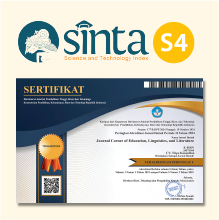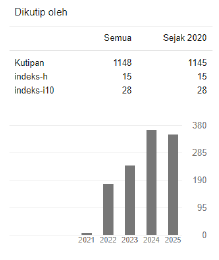Analyzing Teacher-Student Interaction in English-Medium Classrooms: Flanders’ and Initiation-Response-Feedback Model in-Focus
 https://doi.org/10.54012/jcell.v4i1.318
https://doi.org/10.54012/jcell.v4i1.318
 Abstract views: 1498
Abstract views: 1498
 PDF downloads: 551
PDF downloads: 551
Keywords:
education, teachers and student, interaction categories, initiation-response-feedback pattern, PhilippinesAbstract
This study analyzed teacher-student interaction in English-medium classrooms using Flanders’ Interaction Analysis and the Initiation-Response-Feedback (IRF) pattern frameworks. Eight teachers from the College of Teacher Education (CTE) at a private higher institutions participated in the study: three were observed during their teaching process for a total of six hours, and five were interviewed. Using the Flanders’ Model, the main categories involved were indirect teacher talk, direct teacher talk, student talk, and silence. On the other hand, using IRF, the results revealed that head acts involved initiating acts, which consisted of requestives, directives, elicitation, and informatives; responding acts, which composed of positive, negative, and temporization responses; and then follow-up acts, which comprised of endorsement, concession, and acknowledgement. The study underscores the significance of balancing direct and indirect talk to foster more dynamic and interactive classroom environments. Mapping out specific interaction patterns such as initiating insights for educators to refine their teaching strategies and enhance student engagement and learning outcomes.
Downloads
References
Amari, V.O. (2015). The instructional process: a review of Flanders’ interaction analysis in a classroom setting. International Journal of Secondary Education,3(5),43-49. https://ejournal.karinosseff.org/index.php/jadila/article/view/123
Anderson, J. (2019). Cooperative learning: principles and practice. https://www.researchgate.net/publication/331703720_cooperative_learning_principles_and_practice
Aslam, R., Khan, N. (2020). Constructive feedback and students’ academic achievement: A theoretical framework. New horizons, vol.14, no.2, 2020, pp 175-1 98.https://www.researchgate.net/publication/346439698_constructive_feedback_and_Students''_academic_achievement_a_theoretical_framework
Barbadillo, D. J., Barrete, R. G., Ponce, H., & Syting, C. J. (2024). Flanders' interaction analysis category system in action: Analyzing teachers' classroom discourse. Psychology and education: A multidisciplinary journal, 16(6), 637–653. https://doi.org/10.5281/zenodo.10527875
Barberos, M.T., Gozalo, A., & Euberta (2019). The effect of the teacher’s teaching style on students’ motivation. NYU Steinhardt. https://steinhardt.nyu.edu/departments/teaching-and-learning/research/practitioner-action-research/effect-teachers-teaching
Bates and Watson (2020). Teacher and student interaction: An analysis of flint and feedback response pattern. https://www.researchgate.net/publication/377446592_teacher_and_student_interaction_an_analysis_of_flint_and_feedback_response_pattern
Beccles, Ikeda, Kwah, & Otami (2016). International journal of education, learning and development vol.4, issue 10, pp. 1-,14. https://www.eajournals.org/wp-content/uploads/teacher-response-model-for-the-management.pdf
Benton & Li (2021). Teacher clarity: Cornerstone of effective teaching. https://ideacontent.blob.core.windows.net/content/sites/2/2021/05/idea-paper-83_5-21v4.pdf
Bhandari, B. (2021). English teachers’ perspectives on classroom interaction: A phenomenological study.
Borah, M. (2019). Motivation in learning. Journal of critical reviews. vol. 8. isnn2394-5125. https://www.jcreview.com/admin/uploads/files/61c1acf9cfb5a1.40236533
Chen, X., Hu, J., Peng, Y., Yu, H. (2021). Differentiating the learning styles of college students in different disciplines in a college English blended learning setting. https://doi.org/10.1371/journal.pone.0251545
Coristine, S., Russo, S., Beninato, P., Fitzmorris, R., & Rivolta, G. (2022). The importance of student-teacher relationships. Open library. https://ecampusontario.pressbooks.pub/educ5202/chapter/the-importance-of-student-teacher-relation
Creswell, J. W. (2003). Research design: Qualitative, quantitative, and mixed methods approach (2nd ed.). Thousand oaks, CA: Sage. https://www.sciepub.com/reference/159651
Creswell (1994). Chapter III research methodology. https://repository.upi.edu/20582/6/s_ing_1006412_chapter3
Creswell (2012). Educational research planning: Planning, conducting, and evaluating quantitative and qualitative research. https://www.researchgate.net/publication/271429461_educational_research_planning_planning_conducting_and_evaluating_quantitative_and_qualitative_research
Dai (2021). An analysis system of classroom interaction in higher education based on portaal. https://ieeexplore.ieee.org/document/9678560
Deng, J., Du, X., & Zhang, S. (2021). A mixed study on the effectiveness of verbal praise in primary school slass. Science insights education frontiers, 10(1):1353-1363. https://files.eric.ed.gov/fulltext/ej1322561.pdf
Dworkin (2012). Sample size quality for qualitative studies using in-depth interviews. https://www.researchgate.net/publication/230832973_sample_size_policy_for_qualitative_studies_using_in-depth_interviews
Elisdawati, Husein, & Setia (2018). Teachers’ politeness strategies in motivating students to learn English. Kne social sciences. https://knepublishing.com/index.php/kne-social/article/view/2004/4464
Figueroa, C. F. (2001). A contrastive analysis of Spanish and English conversation (1). (linguistica). document - gale onefile: informe académico.https://go.gale.com/ps/i.do?id=gale%7ca104572244&sid=googlescholar&v=2.1&it=r&linkaccess=abs&issn=&p=ifme&sw=w&usergroupname=anon%7e76f1b0c3&aty=open-web-entry%20tsui
Gentrup, Lorenz, Kristen, & Kogan (2020). Self-fulfilling prophecies in the classroom: Teacher expectations, teacher feedback and student achievement. https://www.researchgate.net/publication/338980640_self-fulfilling_prophecies_in_the_classroom_teacher_expectations_teacher_feedback_and_student_achievement/citations
Goodboy & Myer (2008). The effect of teacher confirmation on student communication and learning outcomes. https://www.researchgate.net/publication/279951948_the_effect_of_teacher_confirmation_on_student_communication_and_learning_outcomes
Gray (2021). How educators can help foster feelings of belonging. https://ced.ncsu.edu/news/2021/10/21/why-is-it-important-for-students-to-feel-a-sense-of-belonging-at-school-students-choose-to-be-in-environments-that-make-them-feel-a-sense-of-fit-says-associate-professor-deleon-gra/
Hatch (2002). Doing qualitative research in education setting. https://eric.ed.gov/?id=ed482
Hattie, J. (2018). Why teaching strategies don’t matter. Education week. https://www.edweek.org/teaching-learning/opinion-john-hattie-why-teaching-strategies-dont-matter/2018/01
Henderlong & Lepper (2020). The effects of social comparison versus mastery praise on children’s intrinsic motivation. https://www.researchgate.net/publication/226345112_the_effects_of_social-comparison_versus_mastery_praise_on_children's_intrinsic_motivation
Hoffer, E. R. (2020). Case-based teaching: using stories for engagement and inclusion. International Journal on Social and Education Sciences, 2(2), 75. https://www.ijonses.net/index.php/ijonses/article/view/38
Host, B. (2023). A fascination with educational research and practice. https://www.linkedin.com/pulse/fostering-future-brian-host-sxeic
Huriyah & Agustiani (2018). An analysis of English teacher and student talk in the classroom interaction. https://www.researchgate.net/publication/331795206_an_analysis_of_english_teacher_and_learner_talk_in_the_classroom_interaction
Imbertson, D. (2017). The importance of student talk and strategies for promoting classroom conversations.
Johnson, D. (2017). The role of teachers in motivating students to learn. BU journal of graduate studies in education, volume 9(issue 1). https://files.eric.ed.gov/fulltext/ej1230415.pdf
Kartini, K., Syakira, S., & Aisyah, S. (2022). Initiation-response-feedback pattern used by lecturer-students in EFL classroom interaction. https://www.researchgate.net/publication/362667883_initiation-response-feedback_pattern_used_by_lecturer-students_in_efl_classroom_interaction
Karuniasih, JM., Evenddy, S., Utomo, D., & Sampurna, P. (2019). An analysis of teachers talks in classroom interaction at SMPN 5 Kota Serang. https://www.researchgate.net/publication/350071257
Khiat, H., Vogel, S. (2022). A self-regulated learning management system: Enhancing performance, motivation, and reflection in learning. Journal of University Teaching and Learning Practice, v19 n2 article 4 p43-58 2022. https://files.eric.ed.gov/fulltext/ej1348289.pdf
Kutasi, R. (2023). Feedback: unveiling its impact and enhancing its effectiveness in education. Revista de pedagogie/ journal of pedagogy. https://revped.ise.ro/wp-content/uploads/2024/01/2023.2-1.pdf
Li (2018). L1 in the IRF cycle: A case study of Chinese EFL classrooms. https://sfleducation.springeropen.com/articles/10.1186/s40862-017-0042-y
Margaretha, E. (2015). Teachers’ problems in giving instruction for elementary students of Bethany school
https://repository.uksw.edu/bitstream/123456789/9898/2/t1_112010021_full%20text.pdf
Maziani, A. (2021). Classroom discourse and aspects of conversation analysis: A qualitative study on student-to-student interaction during group discussion in EFL classrooms.http://www.diva-portal.org/smash/record.jsf?pid=diva2%3A1573665&dswid=-9803
McElhone, D., Tenore, F. B., & Davis, D. S. (2017). How teachers mobilize and transform their conceptualizations of reading comprehension into representations of instructional practice. Literacy research: Theory, method, and practice, 66(1), 232.
https://journals.sagepub.com/doi/abs/10.1177/2381336917718502
Miles & Huberman (2014). Qualitative data analysis. https://books.google.com.ph/books/about/qualitative_data_analysis. html?id=3cnrubtu6csc&redir_esc=y
Mousavi, S. N., & Ehsan, N. V. (2021). Teachers’ scaffolding and preferences of display vs. inferential questions: Initiation-response-follow-up (IRF) model. https://jpc.uma.ac.ir/article_1185.html
Noviana, A., & Ardi, P. (2015). Challenges in implementing initiation-response-feedback (IRF) sequences in EAP class. https://www.researchgate.net/publication/330703861_challenges_in_implementing_initiation-response-feedback_irf_sequences_in_eap_class
Palinkas (2015). Purposeful sampling for qualitative data collection and analysis in mixed method implementation research https://www.ncbi.nlm.nih.gov/pmc/articles/pmc4012002/
Pratiwi (2018). Teacher talk and instructional language choice: Two problems encountered in EFL classroom. https://www.researchgate.net/publication/334452451_teacher_talk_and_instructional_language_choice_two_problems_encountered_in_efl_classroom
Rahayu, R. P., & Wirza, Y. (2020). Teachers’ perception of online learning during pandemic covid-19. Journal Penelitian Pendidikan. vol. 20, no. 3. https://ejournal.upi.edu/index.php/jer/article/view/29226
Rhamadina, Alek, Husna, & Hidayat (2023). A discourse analysis of students-teacher pattern interaction in ELT classroom.
https://e-journal.my.id/onoma/article/view/2209
Rizkiyah, F., & Salamah, U. (2023). Analysis of classroom verbal interaction using FIACS (Flanders’ interaction analysis categories system). Darussalam English journal, 3(1), 31–66. https://doi.org/10.30739/dej.v3i1.2234
Rohman, I. (2017). Classroom interaction in English language class for students of economics education. www.academia.edu.
Safitri, A., & Jufrizal. (2021). teacher’s question and students’ responses in EFL classroom interaction. vol. 579
Sande, Eva, Kleemans, T., Verhoeven, L. & Segers, E. (2019). The linguistic nature of children's scientific reasoning. Learning and instruction. 62. 20-26. 10.1016/j.learninstruc.2019.02.002. https://www.researchgate.net/publication/334838352
Saswati, R. (2019). Analysis of classroom interaction using IRF pattern: A case study of EFL conversation class. Scope: Journal of English Language Teaching, 3(1), 29-37.https://journal.lppmunindra.ac.id/index.php/SCOPE/article/view/2782
Selvaraj, A., Radhin, V., Ka, N., Benson, N., & Mathew, A. J. (2021). Effect of pandemic based online education on teaching and learning system. International journal of educational development, 85, 102444. https://doi.org/10.1016/j.ijedudev.2021.102444
Sen (2021). Importance of teacher-student interaction. Editorial - (2021) volume 9, issue 3. https://www.primescholarslibrary.org/articles/importance-of-teacherstudent-interaction-72269.html
Sinclair, J. M., & Coulthard, R. M. (1975). Towards an analysis of discourse: The English used by teachers and pupils. London: Oxford university press. https://www.scirp.org/reference/referencespapers?referenceid=1168984
Sowell, J. (2017). Good instruction-giving in the second-language classroom. English teaching forum. https://americanenglish.state.gov/files/ae/resource_files/etf_55_3_pg1https://repository.uksw.edu/bitstream/123456789/9898/2/t1_112010021_full%20text.pdf0-19.pdf
Sumedi, S., & Rovino, D. (2020). Speech act analysis of English teacher talk at SMP Negeri 1 Rangkasbitung. Journal of English language and culture.https://www.researchgate.net/publication/341523762
Syting, C. J., Cruz, J., Mediano, G., & Tayo, S. (2024). Teacher and student interaction: An analysis of flint and feedback response pattern. Psychology and Education: A multidisciplinary journal. Volume 6 pages 521-540.
Tjalla, M., Syamsir, M., Zulfah, Z., Sunubi, A.H, & Arqam, A. (2023). Exploring classroom interaction patterns in EFL virtual learning. https://journal.uniku.ac.id/index.php/erjee/article/view/7878/0
Valente, Lourenco, Dominguez-Lara, Derakhshan, Nemeth, & Almeida (2022). Teacher’s emotion regulation: Implications for classroom conflict management. https://ro.ecu.edu.au/ajte/vol47/iss8/2/
Wang, C., Zhao, H., & Zhang, H. (2020). Chinese college students have higher anxiety in new semester of online learning during covid-19: A machine learning approach. frontiers in psychology, 11. https://doi.org/10.3389/fpsyg.2020.587413
Willemsen, A., Gosen, M. N., Van Braak, M., Koole, T., & De Glopper, K. (2018). Teachers’ open invitations in whole-class discussions. Linguistics and Education, 45, 40–49. https://doi.org/10.1016/j.linged.2018.03.001
Willis, J. (2018). The value of active listening. Edutopia. https://www.edutopia.org/article/value-active-listening
Wuttke, E., & Seifried, J. (2017). Competence, teacher competence and professional error competence: An introduction. In springer briefs in education (pp. 1–14). https://doi.org/10.1007/978-3-319-52649-2_1
Yulia, M., & Zainil, Y. (2021). An analysis of teacher’s oral feedback in EFL classroom interaction at SMP Negeri 10 Batam. vol 10, no 1 (2021). Journal of English language teaching. https://ejournal.unp.ac.id/index.php/jelt/article/view/111373
Zhao, M. (2021). The characteristics and control strategies of the conflicts between teachers and students in primary and secondary schools in the context of new immigrants. Educational science research, 3, 92-96. https://www.scirp.org/reference/referencespapers?referenceid=3055531
Downloads
Published
How to Cite
Issue
Section
License
Copyright (c) 2024 Anjelyn E. Balaobao, Angel Joyce C. Calapaan, Sheane Ann G. Cubero, Christian Jay O. Syting

This work is licensed under a Creative Commons Attribution-ShareAlike 4.0 International License.
All articles published in the Journal Corner of Education, Linguistics, and Literature are licensed under the Creative Commons Attribution-ShareAlike License (CC BY-SA).

















